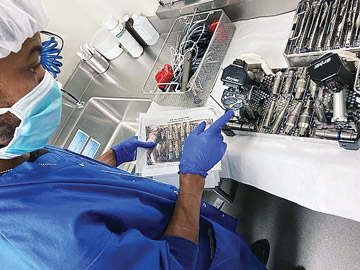It's useful to know in an instant where instrument trays, and even individual tools, are located within your facility. When power tool sets come to the decontamination area from an OR, a member of the CSP team should count the items in the
set. If all the items are accounted for, the set can move forward to the decontam process. If an item is missing, it's a full-stop and the CSP tech — with the assistance of the verification book — identifies the missing piece
and reports it to the CSP supervisor. The supervisor confirms which part is missing and — with the help of instrument tracking software — determines where the set was last used and who last used it, then calls the OR supervisor.
Often the missing piece is found misplaced with an implant set or in a tray for a different instrument set.
Our successes started when we began to communicate and collaborate.
— Carol Gentry, MSN, RN, CNOR
Depending on the model, tracking software employs barcodes, RFID tags and etched markings to help staff locate specific tools in minutes. They're also helpful in monitoring wear and tear on instruments and can help improve the accuracy of
case-costing analyses.
At Johns Hopkins, all instrument sets are scanned before being used in the OR, when they arrive at CSP for reprocessing and again at the decontamination area. "If something is missing, we can go back to the assembly person, frontline clinical
staff or reprocessing tech at the decontamination area to ascertain the instrument's location, or what happened to it," says Ms. Gentry.
Meanwhile, the OR staff determined that the best way to prevent the loss of items on their end was to count the items in each power set before and after they were used in each case. At first, there was pushback, but it was quickly allayed,
because the counts take only a minute or two.
"The reality is that most drill sets have four or eight parts — the one we have with the most components has 21 parts, so while the idea of the counts seemed onerous when suggested, it really wasn't a big deal," says Ms. Gentry.
.svg?sfvrsn=be606e78_3)

.svg?sfvrsn=56b2f850_5)